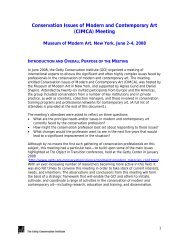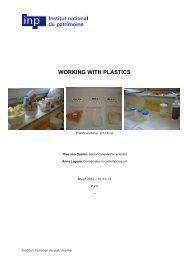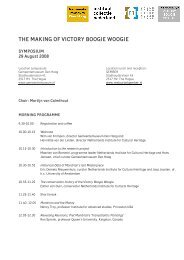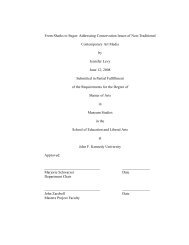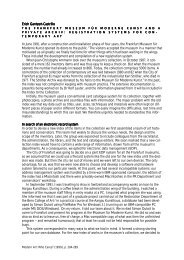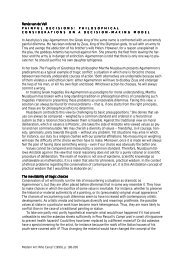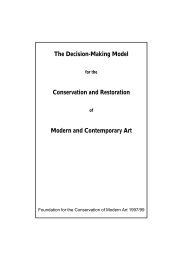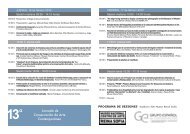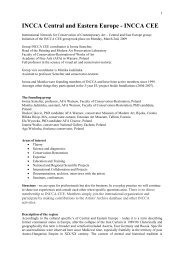commedia dell'arte: when chagall went to frankfurt - incca
commedia dell'arte: when chagall went to frankfurt - incca
commedia dell'arte: when chagall went to frankfurt - incca
You also want an ePaper? Increase the reach of your titles
YUMPU automatically turns print PDFs into web optimized ePapers that Google loves.
and emphasizing the differences in the physical traits of the<br />
theatrical figures.<br />
Fig. 7<br />
of the motif. The brushwork includes thick, wide, well-defined<br />
strokes; smooth passages with little hint of any brushstrokes;<br />
areas where the artist had manipulated the brush in order <strong>to</strong><br />
create local areas of high impas<strong>to</strong>; and areas where a palette<br />
knife was used, Fig. 4.<br />
The colours were worked out and refined as the painting<br />
progressed. Chagall’s characteristic manipulation of the paint<br />
materials and his awareness of each pigment’s nuance of colour<br />
suggest that he was also very involved with the raw materials and<br />
their physical properties.<br />
There are areas where the paint has been heavily worked<br />
as it was built up in many layers, resulting in a somewhat dry<br />
and pasty texture. Soft, irregular blotches of paint were used,<br />
producing a mottled, indefinite effect, Figs 5 and Fig. 6.<br />
Chagall’s palette was composed largely of strong, spectrallypure<br />
colours: cobalt blue, French ultramarine, vermilion, cadmium<br />
yellow, viridian, emerald green, lead white and zinc white.<br />
Mixtures of these pigments are also found <strong>to</strong> give other reds,<br />
oranges, greens, purples and occasionally, browns and blacks. In<br />
addition, other pigments were identified, such as red and yellow<br />
ochres, Naples yellow and Prussian blue. Analyses indicated that<br />
similar pigments were used for both the preliminary drawings<br />
and the Commedia dell’Arte.<br />
Chagall managed <strong>to</strong> explore and obtain the most effective and<br />
vibrant colour contrasts. The result is a surface texture of great<br />
variety and complexity, providing tension in the composition<br />
Fig. 8<br />
Neue Opera lobby with south-facing window glazing. VG Bild-<br />
Kunst, Bonn 2006. Pho<strong>to</strong>: Alexander Bouras.<br />
Neue Opera: the entertainment area, showing the location<br />
of Commedia dell’Arte. VG Bild-Kunst, Bonn 2006. Pho<strong>to</strong>:<br />
Alexander Bouras.<br />
THE OPERA HOUSE ENVIRONMENT<br />
Commedia dell’Arte has always being regarded as a decorative<br />
object for an entertainment area — available only for Opera ticket<br />
holders — where smoking, drinking and eating is allowed.<br />
Large areas of the new Opera building are predominantly<br />
illuminated by daylight — one of the most notable features of<br />
the building. Although daylight can be considered superior <strong>to</strong><br />
any other kind of illumination, its control is difficult <strong>to</strong> reconcile<br />
with conservation demands.<br />
The lobby with its south-facing window glazing has the<br />
highest level of illumination. Both Commedia dell’Arte and the<br />
14 preliminary drawings were displayed just opposite these<br />
windows. It appears that the difficulties that might arise in coping<br />
with natural daylight were not anticipated at an early stage in<br />
the design of the building. On sunny days, the temperature in<br />
the exhibition area also rises dramatically, Fig. 7. Although<br />
conservation standards for works of art on display are published<br />
in a number of books [4, 5], the presence of a conserva<strong>to</strong>r <strong>to</strong><br />
moni<strong>to</strong>r day-<strong>to</strong>-day light and climate conditions is absolutely<br />
necessary.<br />
As in any building which is not designed <strong>to</strong> house works of art,<br />
temperature and relative humidity (RH) are very unstable. The<br />
uncontrollable number of people entering the room during the<br />
opera intervals contributes <strong>to</strong> extra fluctuations in temperature<br />
and RH. The bar area just opposite Commedia, equipped with<br />
two steam coffee machines, is always overcrowded during opera<br />
intervals, Fig. 8. In addition, due <strong>to</strong> the function of this area, it<br />
also appears very difficult <strong>to</strong> control the amount of dirt and dust<br />
as well as noise and vibration.<br />
Finally, hanging such a large and heavy painting inclined<br />
away from the wall posed many challenges and great potential<br />
for serious damage. The installation of Commedia dell’Arte at<br />
the new Opera House created a number of structural problems<br />
<strong>to</strong> the painting.<br />
CONSERVATION TREATMENT<br />
Very little documentation exists in the His<strong>to</strong>rische Museum<br />
records on the condition of Commedia dell’Arte over the years<br />
since its arrival in Frankfurt in 1959. The records that exist<br />
relate <strong>to</strong> the exhibition his<strong>to</strong>ry of the painting and the 14<br />
preliminary drawings. Commedia dell’Arte was pho<strong>to</strong>graphed<br />
and assessed, condition reports were compiled and treatment<br />
proposals formulated as a result of discussions between cura<strong>to</strong>r<br />
and conserva<strong>to</strong>rs.<br />
The stretcher is a seven-member wooden one, with a central<br />
horizontal bar and two vertical ones. The dimensions of the painting<br />
represent those of the stretcher added during framing in 1960<br />
just prior <strong>to</strong> its exhibition. The tacking margins indicate that the<br />
painting was extended by approximately 2 cm on each side. Due<br />
<strong>to</strong> the display system in the Opera House, hanging caused the<br />
stretcher <strong>to</strong> warp slightly and the canvas <strong>to</strong> sag. The condition of<br />
the stretcher was found <strong>to</strong> be sound, and because of its his<strong>to</strong>rical<br />
significance, it was decided not <strong>to</strong> replace it.<br />
The first step was <strong>to</strong> remove a layer of superficial airborne<br />
grime that had accumulated, since the work had never been<br />
surface cleaned. This treatment also allowed the surface <strong>to</strong> be<br />
examined closely in order <strong>to</strong> detect any minor damages that may<br />
have been overlooked. Dust, atmospheric pollutants and dirt were<br />
removed using saliva. Other cleaning solutions tested included<br />
deionized water and 2% tri-ammonium citrate in deionized water,<br />
but none of these cleaning agents removed dirt as much as the<br />
cleaning agent chosen. The procedure began by testing a small<br />
area of the painting judged <strong>to</strong> be least noticeable. At each step of<br />
59



